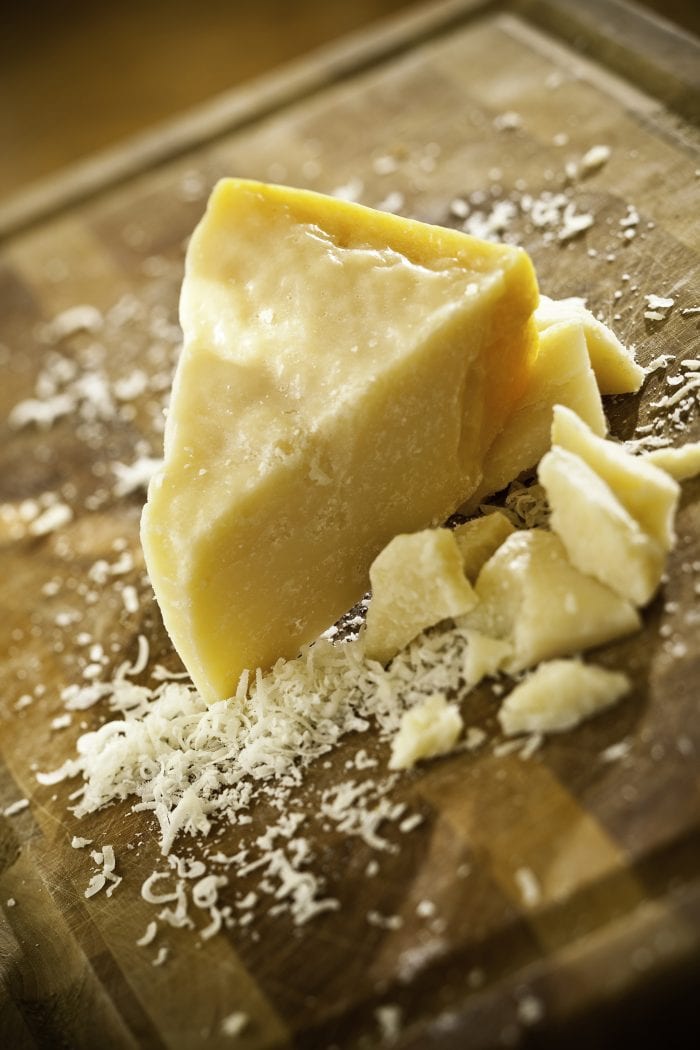By Bob Lipinski

Parmigiano-Reggiano is one of the most popular cheeses on the planet, with a rich history that dates to 1200, recorded on a notarized deed in Genoa. Parmigiano is made in the provinces of Parma, Reggio Emilia, and Modena, in the northeast region of Emilia-Romagna, famous for its Balsamic Vinegar, Mortadella, and Prosciutto di Parma.
Although this “king of Italian cheese” is often referred to as “parmesan,” in 2008 the European Court of Justice ruled that the word “Parmesan” could not be used as a generic term to include Parmigiano-Reggiano. However, parmesan continues to be used as a substitute name for Parmigiano-Reggiano.
Parmigiano is made from cow’s milk and the leftover whey is fed to the pigs used for Prosciutto di Parma. After a minimum of 12 months of aging, cheesemakers determine if the wheel-shaped cheese should be sold or continued to be aged for 24, 36, 40 months or longer. The rind of these gigantic wheels of cheese is embossed all over in a repeating pattern with its name in pin dots and the identification number of the production dairy, the year and month of production.
Parmigiano has a straw-yellow exterior, an inedible golden yellow rind with an oily sheen and a straw-yellow interior comprised of tiny, pale-gold crystals. The cheese is hard, granular, and flaky depending on its age. The longer the cheese ages, the more “crunch” to enjoy. It has a complex, mellow flavor — nutty, buttery, and salty in taste — with a granular smoothness and intense flavor. Parmigiano can be eaten in bite-size chunks when young. When old it is suitable for grating. While other cheeses get sharper as they age, Parmigiano-Reggiano becomes mellower.
When buying the cheese, examine it carefully. It should be a uniform moist but pale amber color with no signs of dryness, white patches or a white rim next to the rind.
To enjoy Parmigiano, take a thin velvety slice of Prosciutto di Parma and put a small piece of Parmigiano in the middle. Drizzle a couple of drops of Balsamic vinegar, then wrap the prosciutto around the cheese and pop it into your mouth.
Parmigiano should be stored in a tight layer of plastic wrap. Every time you use the cheese, use a fresh piece of plastic wrap and refrigerate.
Some recommended Italian wines to serve with Parmigiano include Red: Amarone della Valpolicella, Barbera, Bardolino, Dolcetto, Grignolino, Lambrusco, Montepulciano d’Abruzzo, Nebbiolo, Primitivo, Sangiovese, Valpolicella; White: Cortese, Fiano, Friulano, Orvieto, Trebbiano d’Abruzzo, Verdicchio; Other: dry Marsala, Moscato d’Asti, and Vin Santo.
Bob Lipinski is the author of 10 books, including “101: Everything You Need to Know About Whiskey” and “Italian Wine & Cheese Made Simple” (available on Amazon.com). He conducts training seminars on wine, spirits and food and is available for speaking engagements. He can be reached at www.boblipinski.com OR [email protected].





